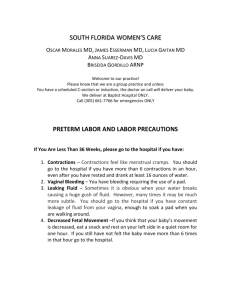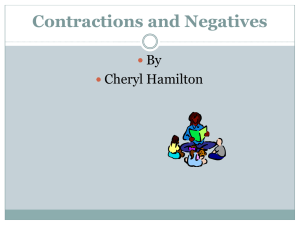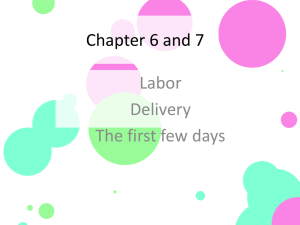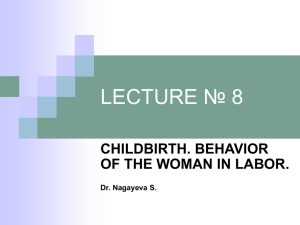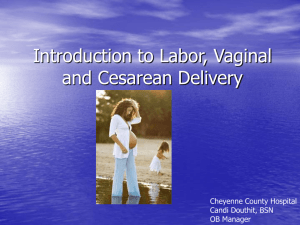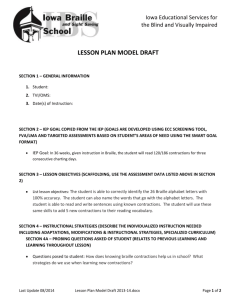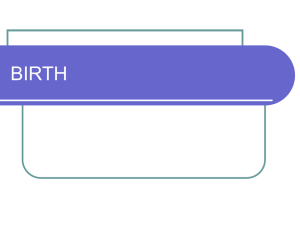Stages of Labor
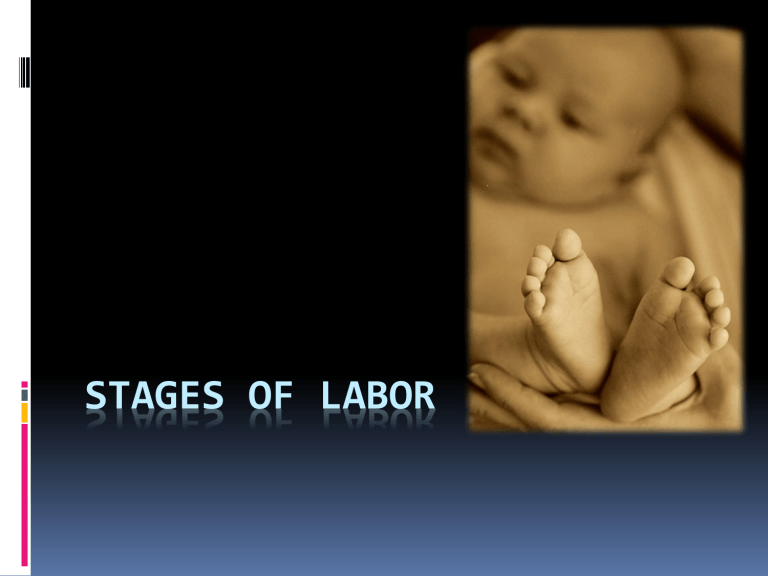
STAGES OF LABOR
What are the stages of labor?
•
•
First Stage- begins with the beginning of contractions that cause progressing changes in your cervix and ends when your cervix fully dilated
Early Labor Phase
Active Labor Phase
Transition phase
Second stage- Continues after the cervix is dilated to 10 cm until the delivery of your baby, sometimes referred to as the “pushing stage”
Third Stage- Delivery of the placenta
First Stage
Early Labor (8-12 hours)
Once your contractions become relatively regular and your cervix begins to dilate, your are officially in early labor.
Contractions with last about 30-45 seconds and give about 5-30 minutes of rest in between contractions
Contractions may feel like aching in your lower back, menstrual cramps, and pressure on pelvis area
Increase in mucusy vaginal discharge, which may be tainted with blood, the so called “Bloody show”
Early labor is most likely to occur in the home, unless a caregiver has told you otherwise
Possible for your water to break (amniotic sac rupture)
Internal Fetal Monitoring- small clip placed on the mother’s stomach where the baby’s scalp is located to monitor the fetal heart rate
Early labor ends when your cervix about 4cm dilated
First Stage cont…
Active Labor (4 to 8 hours)
Contractions are more frequent, longer, and strong, and no longer be able to talk through them
Cervix dilates from 4 to 10 cm
At the end, your baby begins to descend, or it will start to drop contractions will last about 60 seconds, every 5 min, for an hour, when this happens its time to call the midwife or doctor
Transition (few min, to a few hours)
The last part of active labor, when your cervix dilates from 8 to a full 10 centimeters
Contractions are usually very strong, coming every two and a half to three minutes or so and lasting a minute or more
you may start shaking and shivering.
Second Stage (pushing stage)
This is when your cervix has been fully dilated, and its time to push
Lasts from 20 min -2 hours
Contractions will last 45-90sec with a 3-5 minute rest period
Your baby is very low in your pelvis so you will feel pressure on your rectum
Your baby begins to descend with the force of each contraction of your uterus, and with your abdominal muscles helps move the baby through the birth canal. though all the effort your body is putting into the birthing process, only half is being exerted.
Once your uterus is relaxed, the baby’s body moves in a 2 step forward one step back kind of process
Second stage (the baby)
What is happening to the baby?
Baby’s head turns to the side and rests its chin on its chest so the back of the head can push through
Baby shifts, to where it is facing your spinal cord.
The baby will begin to “crown” or emerge from vaginal opening
After the baby’s head is out, its body begins to shift sideways allowing it to easily slip out
Third Stage (5-10 min)
After giving birth uterus begins to contract
These first contractions separate the placenta from uterine wall
Care giver may ask you to push to help move out the placenta
One small push and it comes out
Induced Labor
If labor is delayed and not starting on its own, your practitioner can give you medication and other techniques to stimulate your contractions
1 in 5 births are induced in the US
Sometimes waiting for labor to come naturally is more dangerous to the mother and child than inducing labor
Pregnant 1-2 weeks after due date
If baby gets to big
If mother or child begins having medical issues
When water breaks, and labor has not started yet
Previously had a full term still birth
Induced Labor cont…
How?
Pitocin induction-it is given through a IV line and is used to cause contractions. usually, the amount is increased every 15-30 minutes until a good contraction pattern is achieved.
Amniotomy (breaking the water)- the doctor sends crochet like hook into the vaginal canal, to break the amitotic sac, this causes contractions to begin
Premature Labor
Occurs before the 37 th week of pregnancy due to uterine contractions that cause the cervix to open earlier that normal
Signs and Symptoms
Contractions every 10 min or more, often within one hour
Watery fluid leaving from your vagina (water broke)
Menstrual like cramp/ back aches
Pelvic pressure
Increase in Vaginal discharge/ bloody discharge
Please call health care provider immediately
After call, empty bladder, and lay on your left side and drink fluids this may slow down or stop signs and symptoms
Work cited
http://www.babies.sutterhealth.org/laborand deilvery/index.html
http://www.americanpregnancy.org/labornbir th/prematurelabor.html
http://pregnancy.about.com/od/induction/p/i nduction.htm
http://www.doula4you.net/images/kalenfeet.
jpg

